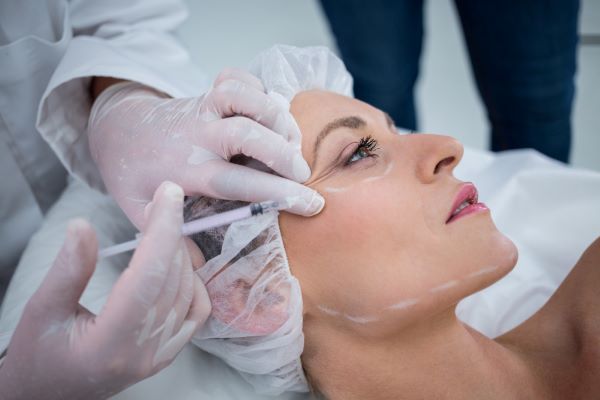As we age, our skin naturally loses volume, elasticity, and smoothness. Wrinkles, fine lines, and hollowness in the face can make us look tired or older than we feel. If you’re looking for a non-surgical way to restore youthfulness and vitality to your skin, dermal fillers might just be the solution you’re looking for. But what exactly are dermal fillers, and how do they work to improve the appearance of your skin? Let’s break it down.
Understanding Dermal Fillers
Dermal fillers are injectable substances used to restore lost volume, smooth out wrinkles, and improve facial contours. These fillers are commonly used to address signs of aging, such as sagging skin, crow’s feet, and deep nasolabial folds (the lines from your nose to the corners of your mouth). Fillers can also be used to enhance facial features like cheeks, lips, and jawlines.
While the most common use for dermal fillers is to smooth out wrinkles, they can do much more than that. These treatments are designed to give your face a more youthful, plump, and refreshed appearance by targeting specific areas of concern.
Types of Dermal Fillers
There are several types of dermal fillers, each made from different materials that work in unique ways. Some of the most popular types include:
Hyaluronic Acid Fillers
Hyaluronic acid (HA) is a naturally occurring substance in the body that helps retain moisture and keep skin hydrated. These fillers are commonly used because they provide instant volume, are relatively safe, and the results are reversible. Common HA fillers include Juvederm, Restylane, and Belotero.
Calcium Hydroxylapatite Fillers
Calcium hydroxylapatite is a mineral-like compound found in bones. These fillers tend to be thicker and are typically used for deeper wrinkles and for adding volume to areas like the cheeks and jawline. Radiesse is a popular calcium-based filler.
Poly-L-Lactic Acid Fillers
This type of filler stimulates collagen production, which helps the skin naturally regain volume over time. Poly-L-lactic acid is typically used for restoring facial volume and is often used in people with more significant signs of aging. Sculptra is a well-known brand in this category.
Polymethyl Methacrylate (PMMA) Fillers
PMMA fillers are semi-permanent and consist of tiny beads suspended in a gel. They are used for deep wrinkles and to provide lasting volume. Bellafill is a widely used PMMA filler.
How Do Dermal Fillers Work?
Dermal fillers work by replenishing the volume that is lost due to aging, sun exposure, or other environmental factors. The injected substance fills in wrinkles and creases, giving the skin a smoother, firmer appearance. The fillers also stimulate the production of collagen, a protein responsible for keeping the skin firm and youthful.
Some fillers, like hyaluronic acid, attract water molecules to the treated area, adding hydration and fullness. Other fillers, like poly-L-lactic acid, work by encouraging the skin to produce its own collagen, providing gradual and natural-looking volume restoration.
Benefits of Dermal Fillers
Dermal fillers offer a range of benefits:
- Instant Results: Most fillers provide immediate results, with noticeable improvements in volume and smoothness.
- Non-Surgical: Fillers are a non-invasive alternative to facelifts or other surgical procedures.
- Minimal Downtime: After the treatment, you can typically return to your regular activities with little to no recovery time.
- Long-Lasting: Many dermal fillers last anywhere from 6 months to 2 years, depending on the type used and the area treated.
- Natural-Looking: When administered correctly, dermal fillers can provide subtle, natural-looking results that enhance your features without looking overdone.
- Enhancing Facial Contours : Dermal fillers can be strategically injected to sculpt and define facial contours, such as the jawline, chin, and lips. Whether you desire more defined cheekbones or fuller lips fillers offer a customizable solution to enhance your natural features.
Common Areas Treated with Dermal Fillers
Dermal fillers can be used on various parts of the face to address different concerns. Some of the most common areas treated include:
- Nasolabial Folds: These are the lines running from the sides of your nose to the corners of your mouth.
- Cheeks: Fillers can restore volume to the cheeks, giving them a youthful, lifted appearance.
- Under-Eyes: Fillers can smooth out hollow areas under the eyes, reducing the appearance of dark circles and bags.
- Lips: Fillers can enhance the size and shape of the lips, creating a fuller, more defined look.
- Jawline and Chin: Fillers can help define the jawline and chin, improving facial contours.
Who Are the Ideal Candidates for Dermal Fillers?
Dermal fillers are ideal for individuals looking to improve facial volume and smoothness without the need for invasive surgery. However, it’s important to be in good health and have realistic expectations about the results. The best candidates are typically those between 30 and 60 years old who are experiencing early to moderate signs of aging.
Before getting dermal fillers, a consultation with a licensed practitioner is essential to determine if the treatment is right for you.
The Procedure: What to Expect
The dermal filler procedure is relatively simple and quick. It usually involves:
- Consultation: Discuss your goals with your practitioner, and they will recommend the best filler for your needs.
- Preparation: The area to be treated may be numbed with a topical anesthetic to minimize discomfort.
- Injection: The filler will be injected into the targeted areas using a fine needle.
- Post-Treatment Care: You may experience mild swelling or bruising, which usually resolves within a few days.
Most dermal filler treatments take about 30 minutes, and results are visible immediately.
Risks and Side Effects
While dermal fillers are generally safe, there are some risks involved, including:
- Bruising and Swelling: These are common after the treatment but usually subside in a few days.
- Infection: Though rare, infections can occur if proper hygiene isn’t maintained.
- Lumps or Irregularities: In some cases, the filler may not be evenly distributed, resulting in lumps.
- Allergic Reactions: Though uncommon, allergic reactions can occur, especially with non-hyaluronic acid fillers.
How Long Do Dermal Fillers Last?
The longevity of dermal fillers depends on the type of filler used, the area treated, and your individual metabolism. Generally, results last anywhere from 6 months to 2 years. For longer-lasting results, treatments may need to be repeated periodically.
Cost of Dermal Fillers
The cost of dermal fillers varies based on the type of filler, the area treated, and the location of the clinic. On average, you can expect to pay anywhere from $500 to $2,000 per session. It’s important to consult with a practitioner to get a clear understanding of the costs involved.
Aftercare for Dermal Fillers
After receiving dermal fillers, it’s essential to follow your practitioner’s aftercare instructions. This might include avoiding strenuous exercise for 24 hours, refraining from massaging the treated area, and avoiding direct sun exposure. These measures help ensure optimal results.
Are Dermal Fillers Safe?
When performed by a qualified and experienced professional, dermal fillers are considered safe. However, as with any cosmetic procedure, there are risks involved. Always choose a licensed practitioner and ensure that they use FDA-approved products.
Dermal Fillers vs. Botox: What’s the Difference?
While both dermal fillers and Botox are used for facial rejuvenation, they work differently. Botox is used to relax muscles and reduce wrinkles caused by movement, such as crow’s feet and forehead lines. Dermal fillers, on the other hand, are used to restore volume and fill in wrinkles caused by the loss of collagen.
Choosing the Right Dermal Filler
When selecting a dermal filler, it’s important to consider factors like the type of filler, the area to be treated, and your skin’s needs. A consultation with a licensed practitioner is crucial to ensure you choose the best option for your desired results.
Conclusion: Are Dermal Fillers Right for You?
Dermal fillers can be an excellent solution for those looking to smooth out wrinkles, restore lost volume, and enhance facial contours without the need for surgery. They offer a quick, non-invasive way to improve the appearance of the skin and create a more youthful, refreshed look. By consulting with a qualified practitioner and understanding your options, you can decide if dermal fillers are the right choice for you.
FAQs
What are dermal fillers made of?
Dermal fillers are typically made of hyaluronic acid, calcium hydroxylapatite, or poly-L-lactic acid, each providing unique benefits for the skin.
How long do dermal fillers last?
The effects of dermal fillers can last anywhere from 6 months to 2 years, depending on the type of filler used.
Are dermal fillers painful?
Most patients report minimal discomfort during the procedure, especially when a topical numbing cream is applied to the area before injections.
Can I go back to work after getting dermal fillers?
Yes, most people can return to work or regular activities immediately after the treatment, though some may experience mild swelling or bruising.
Can dermal fillers be used for non-surgical nose jobs?
Yes, dermal fillers are commonly used for non-surgical nose reshaping, providing a temporary solution to minor imperfections in the nose’s shape.


